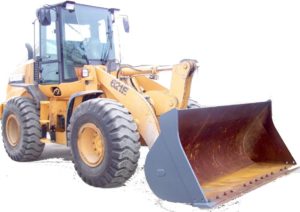INSTANT DOWNLOAD (add to cart)
936 pages, bookmarked, Searchable, Printable, high quality PDF
84243974 – 621E TIER 3 Wheel loader Service Manual.pdf
Revised June 2009
Issued September 2007
Complete digital official shop manual contains service, maintenance, and troubleshooting information for the Case 621E Wheel loader. Diagnostic and repair procedures are covered in great detail to repair, maintain, rebuild, refurbish or restore your Case 621E Wheel loader like a professional mechanic in local service/repair workshop. This cost-effective quality manual is 100% complete and intact as should be without any missing pages. It is the same factory shop manual used by dealers that guaranteed to be fully functional to save your precious time.
This manual for Case 621E Wheel loader is divided into different sections. Each section covers a specific component or system and, in addition to the standard service procedures, includes disassembling, inspecting, and assembling instructions. A table of contents is placed at the beginning of each section. Pages are easily found by category, and each page is expandable for great detail. It is in the cross-platform PDF document format so that it works like a charm on all kinds of devices. You do not need to be skilled with a computer to use the manual.
EXCERPT:
621 E Wheel Loader
Service Manual 84243974
(Replaces 87634756)
Table of Contents
General
Section Index – General
Standard Torque Specifications
Fluids and Lubricants
Metric Conversion Chart
Engines
Section Index – Engines
Description
Engine and Radiator Removal and Installation
Stall Tests
After Cooler
For Engine Repair, See the Engine Service Manual
Fuel System
Section Index- Fuel System
For Fuel System Repair, See the Engine Service Manual
Electrical
Section Index- Electrical
Removal and Installation of Starter and Alternator
Electrical Specifications and Troubleshooting
Batteries
Instrument Cluster
Steering
Section Index – Steering
Removal and Installation of Steering Components
Steering Specifications, Pressure Checks, and Troubleshooting
Steering Cylinders
Center Pivot
Auxiliary Steering Motor and Pump
Joystick Steering
Power Train
Section Index – Power Train
Removal and Installation of Power Train Components
Transmission Specifications, Pressure Checks, and Troubleshooting
Transmission
Front Axle
Rear Axle
Rear Axle, Serial Number N8F203848 and After
Drive Shafts, Center Bearing, and Universal Joints
Wheels and Tires
Transmission Control Valve
Brakes
Section Index – Brakes
Removal and Installation of Brake Components
Hydraulic Brake Troubleshooting
Brake Pump
Brake Accumulators
Parking Brake
Hydraulics
Section Index- Hydraulics
How to Read Hydraulic Schematics
Removal and Installation of Hydraulic Components
Hydraulic Specifications, Troubleshooting, and Pressure Checks
Cleaning the Hydraulic System
Hydraulic Pump
Loader Control Valve
Cylinders
Coupler Solenoid Locking Valve
Ride Control Accumulator
Ride Control Valve
Section Index – Mounted Equipment
Air Conditioning Troubleshooting and System Checks For Systems with HFC-
134a Refrigerant
Air Conditioner System Service
Removal And Installation Of Air Conditioning And Heater Components
Loader
Roll Over Protective Structure (ROPS), Cab Structural Frame (CSF)
Cab Glass Installation
Electrical Schematic Foldouts and Hydraulic Schematic Foldout
The instrument cluster monitors a number of functions and can be tailored to fit the operator’s preferences. The instrument cluster not only monitors machine functions, it warns the operator when caution is needed due to a possible malfunction and when immediate action is needed due to a possible critical malfunction. When the machine is started, the instrument cluster will perform the following self-test:
Self-Test
1. Turn the ignition (key) switch to the ON position.
2. The instrument cluster will automatically check each monitored system.
3. All LED’s (Light Emitting Diodes) will illuminate for 2- 3 seconds.
4. Four gauges will energize for 2- 3 seconds.
5. The warning alarm will sound for 2 – 3 seconds.
6. If there is an open circuit between a sensor and the instrument cluster, the LED will flash and the warning alarm will sound for 5 seconds.
7. If there were no faults detected during the check, all monitored systems will return to normal operation.
8. If only some of the LEDs illuminate, replace the instrument cluster.
9. If the LEDs illuminate, but the warning alarm does not sound, see section 4002 and test the alarm circuit.
10. If the warning alarm sounds but the LEDs do not illuminate, if no power is present at buzzer,
replace the instrument cluster, if power is present at the buzzer, replace the buzzer.
11. If the warning alarm does not sound and the LEDs do not illuminate on the instrument cluster, do the following steps to test the power circuit:
Power Circuit Test
A. Check fuse ECA-F3. If the fuse is bad, replace the fuse and repeat Self-Test. If the fuse is good, go to next step.
B. Check wire 19EA for continuity.
Repair/replace the wire as required. If continuity is found go to next step.
C. Check power relay module A for proper operation, see Section 4002. If the power relay module checks good, go to next step.
D. Check the ignition switch for proper operation, see Section 4002. If the ignition switch checks good, go to next step.
E. Check fuse ECC-F5. If the fuse is bad, replace the fuse.
…

